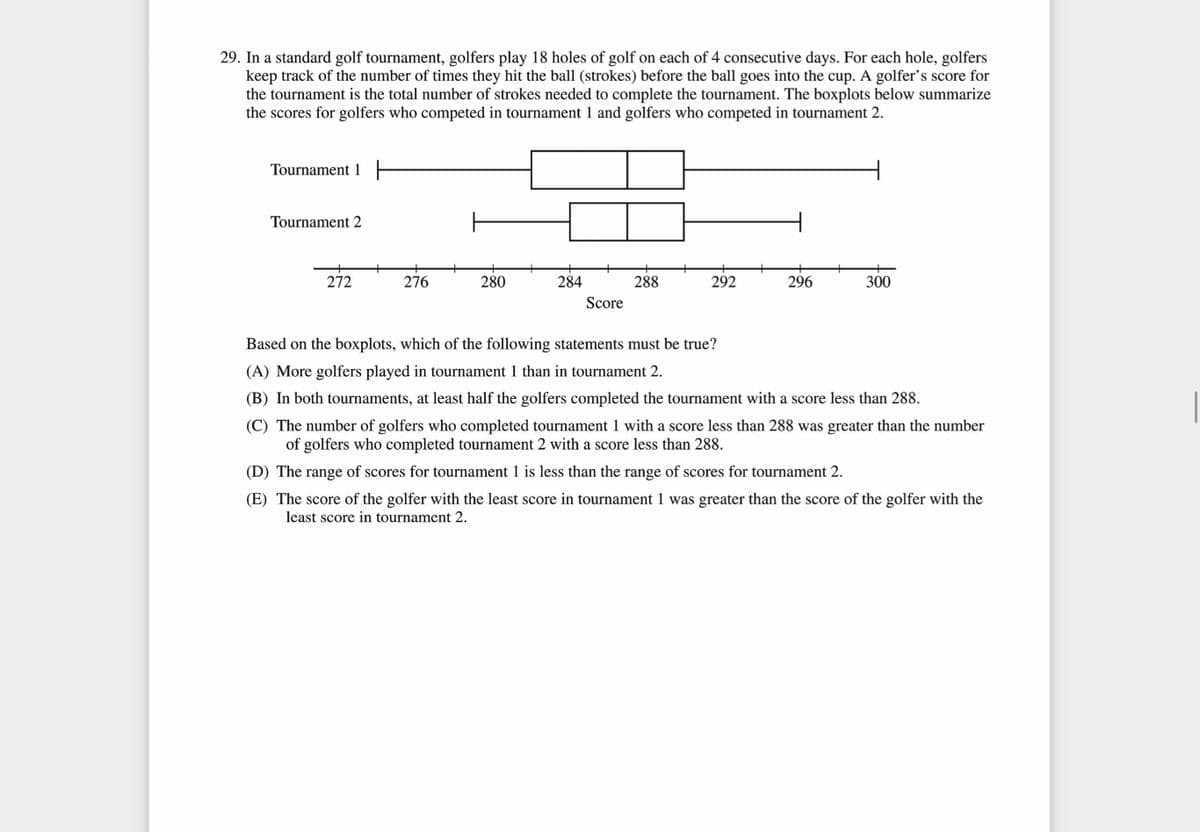29. In a standard golf tournament, golfers play 18 holes of golf on each of 4 consecutive days. For each hole, golfers keep track of the number of times they hit the ball (strokes) before the ball goes into the cup. A golfer's score for the tournament is the total number of strokes needed to complete the tournament. The boxplots below summarize the scores for golfers who competed in tournament 1 and golfers who competed in tournament 2. Tournament 1 H Tournament 2 272 276 280 284 288 292 296 300 Score Based on the boxplots, which of the following statements must be true? (A) More golfers played in tournament 1 than in tournament 2. (B) In both tournaments, at least half the golfers completed the tournament with a score less than 288. (C) The number of golfers who completed tournament 1 with a score less than 288 was greater than the number of golfers who completed tournament 2 with a score less than 288. (D) The range of scores for tournament 1 is less than the range of scores for tournament 2. (E) The score of the golfer with the least score in tournament 1 was greater than the score of the golfer with the least score in tournament 2.
29. In a standard golf tournament, golfers play 18 holes of golf on each of 4 consecutive days. For each hole, golfers keep track of the number of times they hit the ball (strokes) before the ball goes into the cup. A golfer's score for the tournament is the total number of strokes needed to complete the tournament. The boxplots below summarize the scores for golfers who competed in tournament 1 and golfers who competed in tournament 2. Tournament 1 H Tournament 2 272 276 280 284 288 292 296 300 Score Based on the boxplots, which of the following statements must be true? (A) More golfers played in tournament 1 than in tournament 2. (B) In both tournaments, at least half the golfers completed the tournament with a score less than 288. (C) The number of golfers who completed tournament 1 with a score less than 288 was greater than the number of golfers who completed tournament 2 with a score less than 288. (D) The range of scores for tournament 1 is less than the range of scores for tournament 2. (E) The score of the golfer with the least score in tournament 1 was greater than the score of the golfer with the least score in tournament 2.
Glencoe Algebra 1, Student Edition, 9780079039897, 0079039898, 2018
18th Edition
ISBN:9780079039897
Author:Carter
Publisher:Carter
Chapter10: Statistics
Section10.6: Summarizing Categorical Data
Problem 28PPS
Related questions
Question

Transcribed Image Text:29. In a standard golf tournament, golfers play 18 holes of golf on each of 4 consecutive days. For each hole, golfers
keep track of the number of times they hit the ball (strokes) before the ball goes into the cup. A golfer's score for
the tournament is the total number of strokes needed to complete the tournament. The boxplots below summarize
the scores for golfers who competed in tournament 1 and golfers who competed in tournament 2.
Tournament 1 H
Tournament 2
272
276
280
284
288
292
296
300
Score
Based on the boxplots, which of the following statements must be true?
(A) More golfers played in tournament 1 than in tournament 2.
(B) In both tournaments, at least half the golfers completed the tournament with a score less than 288.
(C) The number of golfers who completed tournament 1 with a score less than 288 was greater than the number
of golfers who completed tournament 2 with a score less than 288.
(D) The range of scores for tournament 1 is less than the range of scores for tournament 2.
(E) The score of the golfer with the least score in tournament 1 was greater than the score of the golfer with the
least score in tournament 2.
Expert Solution
This question has been solved!
Explore an expertly crafted, step-by-step solution for a thorough understanding of key concepts.
This is a popular solution!
Trending now
This is a popular solution!
Step by step
Solved in 2 steps with 2 images

Recommended textbooks for you

Glencoe Algebra 1, Student Edition, 9780079039897…
Algebra
ISBN:
9780079039897
Author:
Carter
Publisher:
McGraw Hill

Linear Algebra: A Modern Introduction
Algebra
ISBN:
9781285463247
Author:
David Poole
Publisher:
Cengage Learning

Algebra: Structure And Method, Book 1
Algebra
ISBN:
9780395977224
Author:
Richard G. Brown, Mary P. Dolciani, Robert H. Sorgenfrey, William L. Cole
Publisher:
McDougal Littell

Glencoe Algebra 1, Student Edition, 9780079039897…
Algebra
ISBN:
9780079039897
Author:
Carter
Publisher:
McGraw Hill

Linear Algebra: A Modern Introduction
Algebra
ISBN:
9781285463247
Author:
David Poole
Publisher:
Cengage Learning

Algebra: Structure And Method, Book 1
Algebra
ISBN:
9780395977224
Author:
Richard G. Brown, Mary P. Dolciani, Robert H. Sorgenfrey, William L. Cole
Publisher:
McDougal Littell
